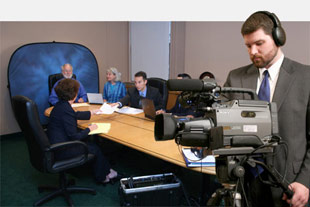Precision-Based Legal Videography for Professional Evidence Filming.
Why Legal Videography Is Crucial for Accurate Legal Record-Keeping
In the realm of legal process, the precision of record-keeping is critical, and lawful videography becomes an important device in this context. By capturing the subtleties of verbal and non-verbal communication, it considerably reduces the potential for misconception that can accompany conventional written documents. Additionally, the preservation of authentic visual proof not only enhances the credibility of statements but additionally contributes to a thorough account of events. As we discover the multifaceted advantages of lawful videography, one must consider its implications for the future of judicial stability and openness.
Relevance of Visual Proof
Developing the importance of visual evidence in legal proceedings is paramount for guaranteeing precise record-keeping and improving the total honesty of the judicial procedure. Aesthetic proof functions as a critical tool in documenting events, conditions, and various other relevant details that may be important to a case. Unlike written accounts, which are susceptible to interpretation and prejudice, aesthetic recordings supply a goal, unalterable representation of facts as they occurred.
This kind of proof can catch a range of aspects, including witness behavior, ecological context, and physical proof, all of which may influence judicial end results. By offering a clear and detailed visual narrative, legal videography eliminates obscurity and assists to protect the authenticity of the evidence.
In addition, aesthetic proof can be critical in lowering disagreements over factual disparities, as it permits a straight comparison against statement and various other recorded documents. In an era where electronic innovation is increasingly widespread, the capability to present aesthetic proof successfully can considerably enhance the general quality of lawful proceedings. Inevitably, the consolidation of aesthetic evidence not only strengthens the documentation procedure however additionally strengthens public count on the judicial system by advertising transparency and liability.
Enhancing Testimony Trustworthiness
The integration of lawful videography into courtroom process significantly improves the reputation of witness statement. By recording the subtleties of verbal and non-verbal interaction, video recordings offer a more thorough depiction of a witness's behavior, emotions, and reliability. This visual documentation permits jurors to observe the witness's body language, facial expressions, and overall comportment, which are vital parts that can affect their perception of testimony integrity.

Additionally, the visibility of video footage can deter witnesses from offering misleading or overstated statements, as they know that their testimony is being tape-recorded. This accountability enhances the stability of the judicial process. Inevitably, lawful videography serves as a vital device in making certain that witness statement is not only properly illustrated my explanation but also watched with heightened trustworthiness by all celebrations involved.
Comprehensive Document Conservation
Comprehensive document preservation is important for preserving the integrity of lawful proceedings. Lawful videography works as a crucial device in this process, providing a precise visual and auditory account of testaments, depositions, and other turning points in an instance. Unlike conventional written records, video recordings record the nuances of body language, tone, and feeling, which are important for recognizing the context and intent behind statements made throughout lawful proceedings.
Including audiovisual elements into record-keeping improves the conservation of evidence, making sure that it remains intact and obtainable throughout the lawful procedure. This is especially vital in cases where the integrity of witness statements might be tested, as aesthetic recordings can validate insurance claims and give clarity. In addition, video records can be important throughout charms or retrials, supplying an unchanged representation of the initial testimony.

Moreover, the capacity to assess video clip evidence allows attorneys to determine vital information that might have been ignored in created documents. By keeping a thorough archive of lawful process with videography, law office can maintain the greatest requirements of accuracy and responsibility, eventually adding to a fairer judicial process.
Streamlining Legal Process
Streamlining lawful process is necessary for improving effectiveness and minimizing delays within the judicial system. Legal videography functions as a crucial device in accomplishing this goal by providing clear and exact aesthetic paperwork of court hearings, depositions, and statements - legal videography. This technology enables real-time recording, making certain that all spoken and non-verbal cues are captured, which can promote quicker resolution of conflicts
The integration of videography right into lawful processes minimizes dependence on standard methods, such as extensive transcripts, which can be time-consuming to generate and examine. By having accessibility to tape-recorded footage, lawyers can quickly reference key minutes, enhancing their capacity to prepare and present instances successfully. This immediacy also assists in the clearing up of testimonies, lowering the capacity for misinterpretation.

Admissibility in Court
Accurate paperwork is vital not just for efficiency yet also for making certain that evidence is permissible in court. Legal videography offers as a crucial device in this process, supplying a dependable see this site aesthetic record of statements, declarations, and events.
To be regarded admissible, lawful videography has to abide by well-known protocols, such as appropriate equipment usage, ideal lighting, and clear sound capture. Additionally, it is necessary to have certified videographers who comprehend the lawful requirements bordering evidence collection. legal videography. The chain of wardship should additionally be maintained to stop any kind of claims of meddling or change
Moreover, lawful videography can enhance the persuasiveness of evidence by supplying jurors with a straight sight of the testimony, permitting a much more engaged understanding of the situation. In recap, the integration of lawful videography right into record-keeping not only supports effectiveness yet additionally bolsters the stability and admissibility of evidence in useful reference court procedures.
Final Thought
In conclusion, lawful videography plays a crucial duty in making sure precise legal record-keeping by providing unbiased aesthetic paperwork. Eventually, the incorporation of lawful videography right into the judicial process promotes transparency and strengthens public depend on in the stability of the legal system.